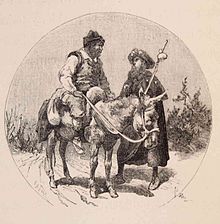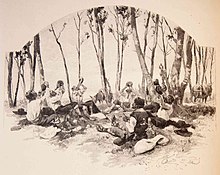- Ricote is also a village formerly inhabited by Moriscoes.
| Ricote | |
|---|---|
| Don Quixote character | |
 Sancho stops his donkey to talk to Ricote. Illustration by
Ricardo Balaca. | |
| Created by | Miguel de Cervantes |
| In-universe information | |
| Gender | Male |
| Children | Ana Félix |
| Religion | Roman Catholic (but not devout) |
| Nationality | Spanish |
Ricote is a fictional character who is referred to in Miguel de Cervantes' novel Don Quixote. He was a wealthy ( rico meaning "rich" in Spanish) Morisco shopkeeper and old friend of Sancho Panza, who was banned from Spain in 1609 like all Moriscos. The expulsion of the Moriscos was a highly topical issue at the time when Don Quixote was written - occurring in between the publication of the first part (1605) and the second one (1615).
In 2006 Govert Westerveld asserted [1] that the Morisco Ricote came from the Ricote Valley, which hypothesis was confirmed by the expert of Moriscos, Prof. Francisco Márquez Villanueva [2] of the Harvard University.

When Sancho leaves Barataria, he meets Ricote, [3] returning in a group of German pilgrims. After meeting Sancho again, Ricote tells him that after the expulsion, he went north while his family went to Algiers. Ricote and the pilgrims share food with Sancho, including "the black dainty called, they say, caviar". He tells him that he came back to recover some gold which he had buried near his house. Ricote recognizes to be a bad Christian and then asks Sancho to help him carry the money away. But Sancho refuses as it would be a treason to his king.
Later [4] Sancho and Don Quixote meet Ricote and his daughter Ana Félix in Barcelona. She is a fervent Christian and has been rescued from Berbery by a young noble neighbour from Sancho and Ricote's village. Her beauty and sincere faith convinces the authorities to arrange the re-admission of the Ricotes in Spain.
See also
- As a contrast in the perception of Moriscos, the first part of Don Quixote, published in 1605, is said by Cervantes to have been an Arabic found manuscript by some Cide Hamete Benengeli, translated for Cervantes by a Morisco.
- List of characters in Don Quixote
References and notes
- ^ Westerveld, Govert (2007). Miguel de Cervantes Saavedra, Ana Félix y el morisco Ricote del Valle de Ricote en "Don Quijote II" del año 1615. (capítulos 54, 55, 63, 64 y 65). ISBN 84-923151-5-6
- ^ Marquez Villanueva, Francisco (2010) Moros, moriscos y turcos en Cervantes. Ensayos críticos. ISBN 978-84-7290-498-9.
- ^ Don Quixote de la Mancha - Part Two: Chapter LIV
- ^ Chapter LXIII